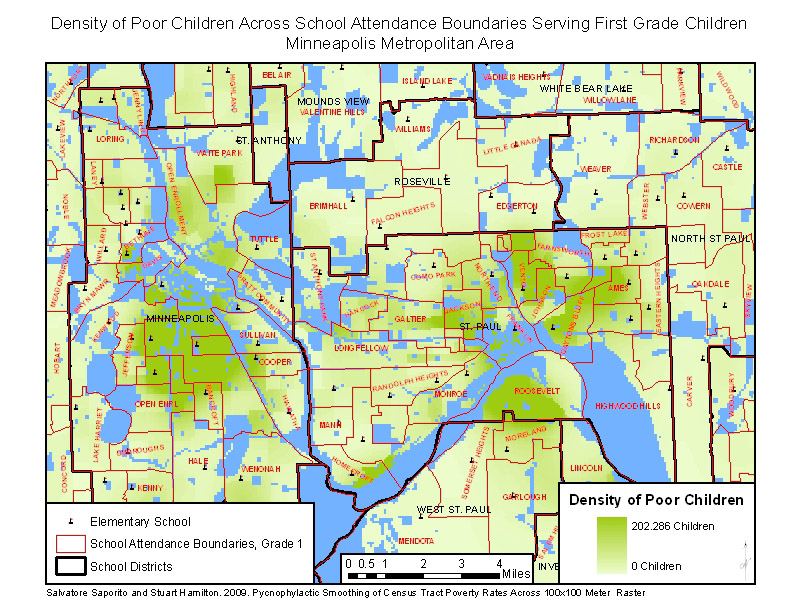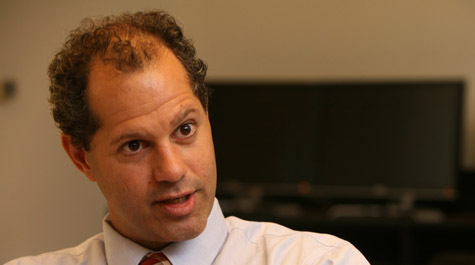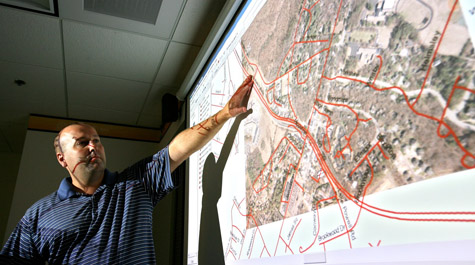W&M professor receives $1 million NSF grant
Salvatore Saporito, an associate professor of sociology at William & Mary, has received a $1 million grant from the National Science Foundation to create a new database of school attendance boundaries for the country's largest school districts.
The grant funds two years of work on the School Attendance Boundary Information System (SABINS). Saporito will build the SABINS database in conjunction with Stuart Hamilton, director of William & Mary's Center for Geospatial Analysis, and Petra Noble and Rob Warren of the Minnesota Population Center at the University of Minnesota. With the assistance of William & Mary undergraduate student researchers, the team will use Geographic Information Systems (GIS) technology to map school attendance boundaries for 800 of the largest school districts nationwide. Elementary, middle and high school attendance boundaries delineate the geographic areas from which schools draw their students.
"This million-dollar grant from the National Science Foundation is great news for William & Mary," said William & Mary Provost Michael Halleran. "Sal Saporito and his colleagues are doing splendid work. These much sought after grant dollars will enable them both to conduct important research on a vital social issue and to engage their undergraduate students in their work."
 Most of the grant money - approximately $786,000 - will come to William & Mary for the project. The data that will be collected -- including digital GIS maps, demographic data and educational statistics-- will be made available to the social science research community through the University of Minnesota's National Historical GIS Web site (www.nhgis.org). The database will allow researchers to conduct large-scale studies that were never possible before.
Most of the grant money - approximately $786,000 - will come to William & Mary for the project. The data that will be collected -- including digital GIS maps, demographic data and educational statistics-- will be made available to the social science research community through the University of Minnesota's National Historical GIS Web site (www.nhgis.org). The database will allow researchers to conduct large-scale studies that were never possible before.
"I am very excited about the opportunities this significant grant brings to our department and to our students," said Thomas Linneman, chair of William & Mary's Department of Sociology. "SABINS cements Sal's standing in an important field in the social sciences, and it's great to have this expertise at William and Mary. As the College and the Sociology Department move further toward providing valuable research experiences for our students, this project and the research opportunities it provides could not have come at a better time."
The origin of SABINS
The project builds on research that Saporito has been conducting since his days in graduate school. His most recent project, in which he and fellow William & Mary Sociology Professor Deenesh Sohoni analyzed the effect of school choice on economic segregation in schools, was based upon school attendance boundaries for the 22 largest school districts in the nation. Following the completion of that project, Saporito was encouraged by fellow demographers to create a new, publicly available database that included many more school districts.
As Saporito began looking into the possibility of such an undertaking, another project was beginning at William & Mary. Greg Hancock, associate professor of geology, and John Swaddle, associate professor of biology and director of the environmental science and policy program, were building an interdisciplinary GIS center at William & Mary. When Saporito heard about their initiative to build a new GIS center, he made sure that most of his SABINS project would come to the College.
"William & Mary is a great home for this kind of enterprise because it allows us to integrate top-notch students into a major research project," he said.
Saporito designed the SABINS project to support that integration. The grant funds eight undergraduate research assistants per semester and more during the summer. The project funds two full-time GIS experts: a GIS programmer and a spatial database engineer. Much of the project's work will be done in the new Center for Geospatial Analysis, which is located in Swem Library in the Copy Center's former location.
"We will have a lab full of students who are ambitious, eager to learn Geographic Information Systems and who will complete complex data processing and analysis with GIS and statistical software. We have some of the best students in the country," he said.
Many of Saporito's former students, including Laura Nixon '05 and Amin Vafa '07 are currently demographers at the U.S. Census Bureau after having worked with Saporito on GIS projects similar to SABINS. This past summer Roxanne Lepore '10, who is the first research assistant to work on the SABINS project, collected digital GIS files for roughly 80 school districts. She has begun using these data for her own research project.
Saporito expects that many of the student assistants for the new project will come from the popular GIS classes that Hamilton teaches and the new Mellon/QEP grant-funded GIS course that Saporito began teaching this semester. That course, which focuses on GIS applications for the social sciences, was developed around the SABINS project.
"The goal was to teach a course in which I avoided fabricating examples of how GIS might work in the real world. Instead, by analyzing original GIS data, students encounter real situations that researchers have not seen before because we don't fully understand how different districts delineate their school geography. Students have to use GIS to solve the unique challenges they encounter," said Saporito.
The need for SABINS
Saporito said that the project is needed because researchers right now only have "census tracts" or "block groups" to work with, and the general public does not know what those are and, thus, does not use them to make every-day decisions in their daily lives. He added that information describing populations living within school attendance boundaries would provide a much better representation of neighborhoods and school attendance boundaries themselves. However, right now, census geography does not correspond with school attendance boundaries. Though independent researchers have connected census data to school attendance boundaries for a handful of districts in the nation, a nation-wide effort on this front had not yet been made.
During the SABINS project, researchers will collect school attendance boundaries and process them in GIS. They will then devise a series of rules to ensure that all of the GIS information they collect from various districts is uniform and can be easily used by the social science research community. SABINS researchers will integrate that GIS data with information from the 2010 census, the American Community Survey and the U.S. Department of Education's Common Core of Data. The initial SABINS data will describe the social and economic characteristics of roughly half of school-aged children living in over 10 thousand elementary, middle, and high school catchment areas.
Saporito said that the project will have myriad of applications for public policy and academic research. Using data from SABINS, researchers will, for the first time, be able to conduct large-scale studies on topics such as the impact of school quality on housing prices, how social conditions in school boundaries influences the educational and health outcomes of children, and how the delineation of school catchment areas impacts educational inequality. In addition to its ability to allow researchers to better explore what's really happening within school districts, SABINS also has the potential to save government agencies and school districts money. For instance, right now the Department of Agriculture administers about $17 billion in subsidized school meals to students around the country. Schools give "free lunch" applications to students and completed applications are used to tally the number of children in each school who are eligible for a subsidized meal. These tallies are expensive to create and are often inaccurate. Some children do not return their applications and others provide inaccurate information. Using SABINS, school districts and the Department of Agriculture could determine how many students are in need of lunch assistance in a more efficient and accurate way, potentially reducing the huge administrative costs that currently result from the current system. Indeed, Saporito and Hamilton recently gave an invited presentation at the National Academy of Sciences to discuss how SABINS data could contribute to alternative ways of distributing lunches in schools.
"It's a fertile ground for original research," said Saporito. "I'll be able to publish plenty of articles from the dataset itself, but it has much, much wider applications than I'll have time to leverage, and that's what makes this data infrastructure project exciting."
Saporito said the project has received support from numerous people at William & Mary, including his colleagues in sociology and faculty members across campus. For example, Robert Hicks, associate professor of economics, Paul Manna, associate professor of government, and Tom Ward, associate dean of the school of education, all wrote support letters that were submitted with the NSF grant proposal. The administration, including Dean of Arts & Sciences Carl Strikwerda, Dean of Undergraduate Studies Susan Peterson and Vice Provost for Research Dennis Manos provided valuable seed money for the project.
Though the NSF grant funds two years of research, Saporito imagines the full potential of the project will not be realized for another decade. The goal is to increase the number of school districts that are included in the initial SABINS data and to continually update the data set so that its reflects changes that result from school rezoning. Creating a comprehensive, longitudinal data set will increase the usefulness of the initial data. Saporito ultimately hopes that by building the SABINS dataset, William & Mary makes a new and vital contribution to the health and welfare of our children.
















